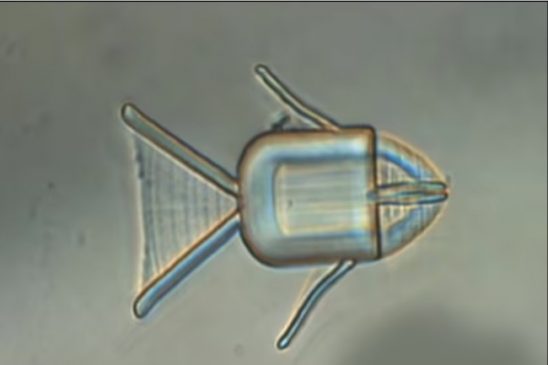Microscopic robot ‘fish’ could soon be used to deliver chemotherapy drugs directly into the tumours of cancer patients By MAIL ON SUNDAY REPORTER
Fish-shaped ‘microrobots’ could be used to deliver chemotherapy drugs directly into tumours, sparing cancer patients from some of the worst side effects of the treatment.
The microscopic robots, which are one-hundredth of a millimetre in size, have been made my Chinese scientists using a special 3D printing technique, from a gel that changes shape when exposed to different pH levels.

They then bathed the ‘fish’ in an iron oxide solution, which makes them magnetic, before loading its ‘mouth’ with chemo medication.
It could be injected into a blood vessel then guided my magnets to the location of a tumour.
Cancer cells cause the pH levels in the fluids surrounding them to become more acidic and, reacting to this, the robot changes shape and opens it’s ‘mouth’ discharging chemotherapy drugs contained inside.
The microscopic robots (pictured), which are one-hundredth of a millimetre in size, have been made my Chinese scientists using a special 3D printing technique, from a gel that changes shape when exposed to different pH levels
They have only been tested in petri dishes so far and the experts say, before they are put into use, the robots would have be made even smaller.
At present, chemo drugs are injected into body and travel through the circulation freely, killing cancer cells but also causing ‘collateral damage’ to healthy cells – and side effects, such as hair loss.
The robots might offer a more precise way to administer these drugs, said the researchers.
Pollution raises blood pressure
Living in areas of high air pollution may cause high blood pressure, a Spanish study suggests.
Researchers at the Biomedical Research Institute of Málaga and other institutes recruited 1,100 volunteers between 2009 and 2010, who underwent physical screening. None had high blood pressure at the start of the study.
They also looked at air pollution levels where the volunteers lived and worked – based on measurements taken at air quality stations – specifically, at concentrations of compounds named particulate matter 10, or PM10, and particulate matter 2.5, or PM2.5.
Living in areas of high air pollution may cause high blood pressure, a Spanish study suggests
In 2016 the study group was reassessed, by which time 282 had developed high blood pressure, or hypertension.
The scientists discovered than the volunteers who lived in areas where concentrations of PM10 and PM2.5 were highest – indicating that air pollution, in general, was worst – were almost 50 per cent more likely to have developed high blood pressure, than those who lived in areas of least pollution.
Lead researcher Gemma Rojo, said: ‘Our data is consistent with a large body of evidence suggesting that air pollution may contribute to the pathogenesis of hypertension.’
Nearly eight in ten UK medical professionals say they are concerned that other healthcare workers are discussing cases over social media.
According to a survey of 1,100 medical professionals in the UK, 78 per cent said they were alarmed by the use of social media platforms like Whatsapp, Facebook, and Instagram to make medical diagnoses.
More than half of respondents said they had received advice from other medical professionals on one these platforms, while 54 per cent said there needed to be tighter regulation on what healthcare workers could discuss online, due to concerns about data protection and confidentiality.
The survey was carried out by Wondr Medical, a new social media platform designed for medical professionals, which says it will enforce medical regulations, such as the anonymity of patients.
Justin Davies, founder of Wondr Medical said: ‘Research shows there is a growing concern and need for a regulatory compliant social network for the medical community.’
More than half of Britons incorrectly believe there is a cure for Parkinson’s, according to a new survey.
The charity Parkinson’s UK, polled 2,000 British adults and found that 57 per cent wrongly believe there are treatments available which can halt or slow the progression of the condition.
Parkinson’s disease is a condition in which parts of the brain become progressively damaged over many years.
Symptoms including involuntary shaking, slow movement, and stiff, inflexible muscles.
Currently, there is no cure for the condition and current treatments only mask the condition.
Dr Beckie Port, Research Communications Manager at Parkinson’s UK, said: ‘Parkinson’s is the fastest growing neurological condition in the world and at the moment, there is no way to stop, slow or reverse it.
‘Yet this survey shows that there is a public misconception that we already have the treatments needed to stop the condition in its tracks.
‘This is really worrying and could hold back progress towards finding a cure.’



